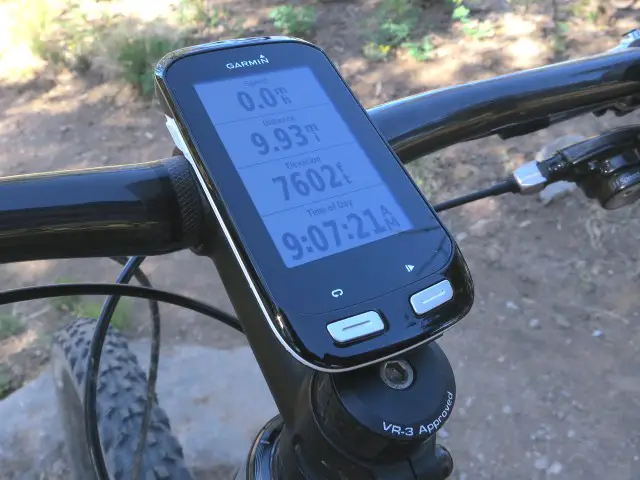
New this spring, Garmin’s range-topping Edge 1000 model brings smart phone and social networking features to the range as well as a usefully large 3in (diagonal) touch screen. When connected via Garmin’s with the user’s smartphone, the new computer has the ability to display the number of incoming calls as well as, for those of us using iPhones, the text of SMS messages (not tested).
Available both as a £440/$600 head unit and a £500/$700 Performance Bundle, the latter includes an ANT+ speed sensor (more accurate than GPS alone), cadence sensor, and heart rate monitor – all of which will speak more to the road user or dedicated trainer (trainee?) than the mountain rider. That said, all three accessories attach without tools for easy swapping between bikes/bodies and wake reliably and quickly once motion is sensed. An accidental factory reset (be sure to respond ‘no’ when asked if that’s really what you want to do) lost the cadence sensor for a couple of days, but otherwise pairing was straightforward and robust.
Far, far easier to configure than earlier Garmin units, the Edge 1000 allows the rider to create profiles for different activities – say mountain, road, commuting, navigating, or racing – with screens and navigation preferences tailored to each. Within each profile, up to five data screens can be configured, each displaying up to eight different types of information. There are literally dozens of options for data, from the usual speed, time, and distance to (pressure-based) elevation, temperature, and ETA at destination. Map, compass, elevation, lap summary, and virtual partner screens can also be toggled for each activity profile, preventing unneeded screens from showing at all. The touch screen makes customisation very straightforward and the inclusion of a temperature readout has given your desert-based reviewer something new to fixate on (sadly, no udometer is provided for precipitation).
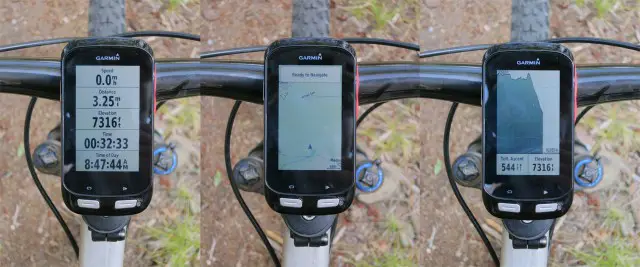
Customisation aside, navigation and mapping are where the Edge 1000 really shines. Loaded via Garmin’s Connect website with an existing GPX track, the computer guides the rider unobtrusively- keeping mum when on track and providing pleasant and easily-understood audio cues when leaving the course or rejoining it. Once the rider learns to trust the tones, it becomes easier to focus on the trail ahead than constantly looking down at the (larger but still fairly) small digital map.
Our US-market sample came pre-loaded with maps of the ‘States with surprising resolution and detail- remote forest roads are included and even some major trails. The computer actually has the ability to navigate back to the start of the ride or a chosen destination, favouring or avoiding trails, tarmac, or motorways based on rider preferences. Should you find yourself (after a long descent, naturally) in a strange village, the Edge should help your group decide if it’s best to head back up over the pass or down the road to get back to the carpark/chalet/pub.
Performance-wise, the ability to determine location from Russian GLONASS as well as the more common GPS satellites means that our Edge 1000 has quickly and reliably located itself and has yet to get lost in the ‘searching for satellites’ purgatory in which older generations found themselves at times. The capacitive touchscreen works well even when damp and muddy- though unsurprisingly does respond better to full-finger gloves designed to work with gadgets. The low backlight has the ability to switch on and off as ambient lighting demands, saving batteries and (operator) brainpower. The battery readily outlasts your reviewer’s legs, taking a full 8.5 hours of navigating to trigger the low battery warning- after which it ran another 45 minutes before stopping seemed like a really, really good idea. Need to get closer to the best-case fifteen-hour run time? Switch GLONASS off or connect a secondary power source (such as an external battery or hub dynamo) and keep rolling.
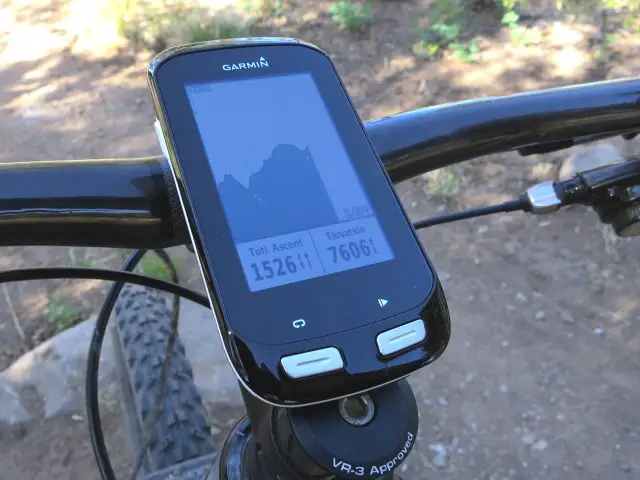
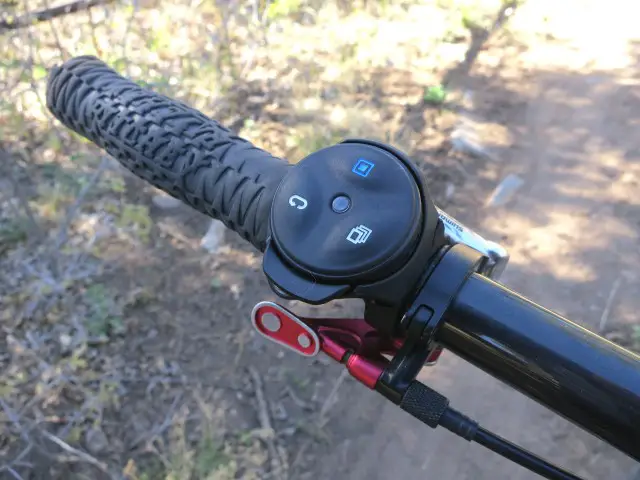
The optional Edge Remote (£40/$50) is a handy add-on that wirelessly brings the lap, ‘next screen’ and programmable ‘other’ button to within thumb’s reach. Again using the low-power ANT+ protocol, the remote is relatively compact and can be rotated in its bar mount to bring the two most-used buttons quite close by. It does a better job at paging through screens than a touchscreen swipe- particularly on bumpy trails. For those who have bought into the Garmin ecosystem, the Remote’s best feature is its ability to be programmed to start and stop Virb camera recording from the bars.
Yes, the Edge 1000 pushes the boundaries of what one might pay for a cycle computer. Thus far, it has also been the most user-friendly, customisable, and reliable unit this reviewer has tried. The smartphone-enabled network functions will only speak to hyper-connected rider, but the ability to race against real or hypothetical competitors (using Garmin’s Strava-esque “segments or a fixed-speed robot frenemy) are surprisingly effective at turning solo rides up to 11. That said, it will take sharing with the road bike to make the most of its accessories and capabilities.
Overall: With the Edge 1000, Garmin have created an interface that surpasses that of all but the best consumer electronics, making all of the device’s impressive capabilities actually useful. Which itself deserves high praise.
Review Info
| Brand: | Garmin |
| Product: | Edge 1000 Performance Bundle |
| From: | Garmin |
| Price: | Bundle £500/$700 |
| Tested: | by Marc B for Two months |
Comments (0)
Leave Reply
Post Comment
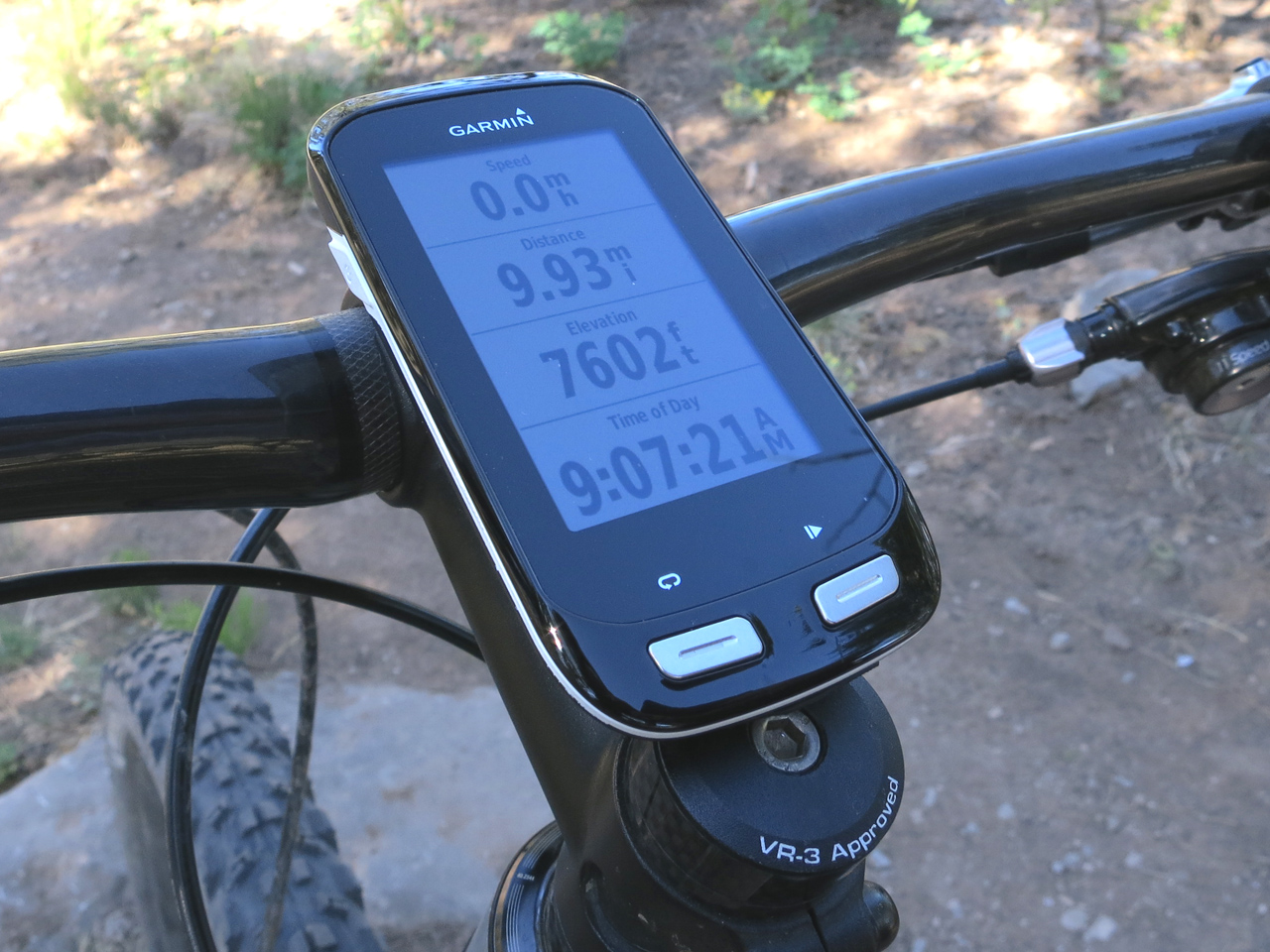

First ride out mine came off the mount on a nite ride spent the next 20 min , looking for it !!!
Only found it when it paired back up to my phone , now I use the little lanyard and wrap that round my bars ..
Battery life is not that good ..